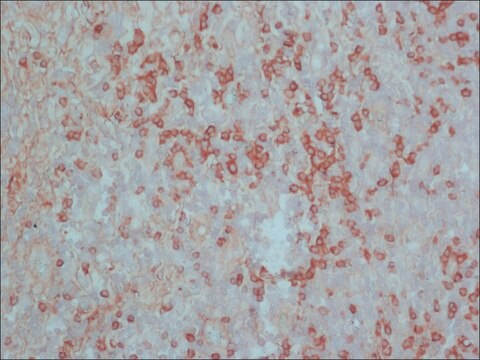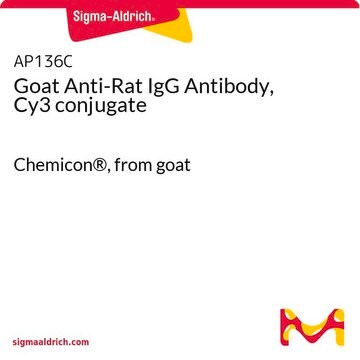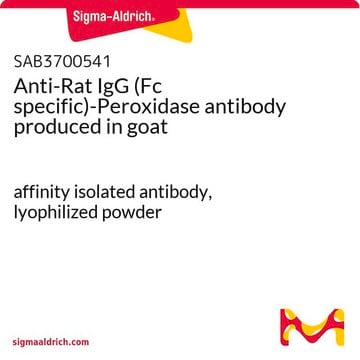AP136R
Goat Anti-Rat IgG Antibody, Rhodamine conjugate
Chemicon®, from goat
Sign Into View Organizational & Contract Pricing
All Photos(1)
About This Item
UNSPSC Code:
12352203
eCl@ss:
32160702
NACRES:
NA.46
Recommended Products
biological source
goat
Quality Level
conjugate
TRITC conjugate
rhodamine conjugate
antibody form
F(ab′)2 fragment of affinity isolated antibody
antibody product type
secondary antibodies
clone
polyclonal
species reactivity
rat
manufacturer/tradename
Chemicon®
technique(s)
immunofluorescence: suitable
shipped in
wet ice
target post-translational modification
unmodified
Related Categories
Specificity
Rat IgG (H +L)
FLUOROPHORE/ PROTEIN:
A550/A280 = .52
WAVELENGTH:
Absorption peak = 550 nm, Emission peak = 570 nm.
FLUOROPHORE/ PROTEIN:
A550/A280 = .52
WAVELENGTH:
Absorption peak = 550 nm, Emission peak = 570 nm.
Application
Research Category
Secondary & Control Antibodies
Secondary & Control Antibodies
Research Sub Category
Whole Immunoglobulin Secondary Antibodies
Whole Immunoglobulin Secondary Antibodies
Suggested dilution for most applications: 1:50-1:200
Optimal working dilutions must be determined by end user.
Optimal working dilutions must be determined by end user.
This Goat anti-Rat IgG Antibody, Rhodamine conjugate is validated for use in IF for the detection of Rat IgG.
Physical form
Lyophilized. Buffer=0.01 M Sodium Phosphate, 0.25 M NaCl, pH 7.6 with 15 mg/mL BSA and 0.05% sodium azide.
RECONSTITUTION:
Reconstitute with 2 mL of sterile distilled water
RECONSTITUTION:
Reconstitute with 2 mL of sterile distilled water
Storage and Stability
Maintain lyophilized product at 2-8°C for up to 12 months. After reconstitution the product is stable for several weeks at 2-8°C as an undiluted liquid. For extended storage after reconstitution, add an equal volume of glycerol to make a final concentration of 50% glycerol followed by storage at -20°C in undiluted aliquots for up to 12 months. Please note the concentration of protein (and buffer salts) will decrease to one-half of the original after the addition of glycerol. Avoid repeated freeze/thaw cycles.
Legal Information
CHEMICON is a registered trademark of Merck KGaA, Darmstadt, Germany
Disclaimer
Unless otherwise stated in our catalog or other company documentation accompanying the product(s), our products are intended for research use only and are not to be used for any other purpose, which includes but is not limited to, unauthorized commercial uses, in vitro diagnostic uses, ex vivo or in vivo therapeutic uses or any type of consumption or application to humans or animals.
Not finding the right product?
Try our Product Selector Tool.
Hazard Statements
Precautionary Statements
Hazard Classifications
Aquatic Chronic 3
Storage Class Code
11 - Combustible Solids
WGK
WGK 3
Certificates of Analysis (COA)
Search for Certificates of Analysis (COA) by entering the products Lot/Batch Number. Lot and Batch Numbers can be found on a product’s label following the words ‘Lot’ or ‘Batch’.
Already Own This Product?
Find documentation for the products that you have recently purchased in the Document Library.
Jung Hwa Ko et al.
Cell reports, 30(11), 3806-3820 (2020-03-19)
The cross-talk between mesenchymal stem and stromal cells (MSCs) and macrophages is critical for the restoration of tissue homeostasis after injury. Here, we demonstrate a pathway through which MSCs instruct macrophages to resolve inflammation and preserve tissue-specific stem cells, leading
Kyoung Woo Kim et al.
Translational vision science & technology, 9(7), 38-38 (2020-08-25)
To investigate the effect of preserved corneal lamellar grafting on inflammation and wound healing and to compare its effect with that of preserved scleral grafting in a scleral defect rabbit model. New Zealand White rabbits were assigned to a corneal
Moufida Ben Nasr et al.
Diabetes, 71(7), 1579-1590 (2022-05-03)
Recent studies have shown that severe acute respiratory syndrome coronavirus 2 (SARS-CoV-2) infection may induce metabolic distress, leading to hyperglycemia in patients affected by coronavirus disease 19 (COVID-19). We investigated the potential indirect and direct effects of SARS-CoV-2 on human
Keunok Jung et al.
Frontiers in immunology, 13, 1034774-1034774 (2022-11-22)
Tumor-targeting antibody (Ab)-fused cytokines, referred to as immunocytokines, are designed to increase antitumor efficacy and reduce toxicity through the tumor-directed delivery of cytokines. However, the poor localization and intratumoral penetration of immunocytokines, especially in solid tumors, pose a challenge to
Kyoung Woo Kim et al.
Cell death & disease, 11(4), 285-285 (2020-04-26)
Fucosylation is a biological process that plays a critical role in multiple cellular functions from cell adhesion to immune regulation. Fucosyltransferases (FUTs) mediate fucosylation, and dysregulation of genes encoding FUTs is associated with various diseases. FUT1 and its fucosylated products
Our team of scientists has experience in all areas of research including Life Science, Material Science, Chemical Synthesis, Chromatography, Analytical and many others.
Contact Technical Service






